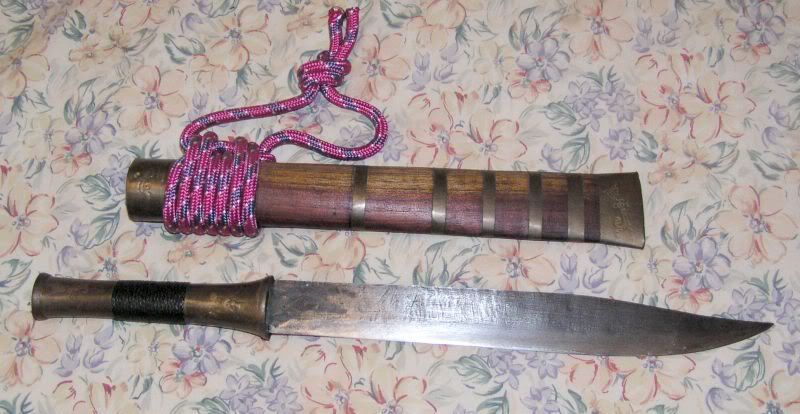
 |
|
|
|
|
#1 |
|
Member
Join Date: Oct 2007
Posts: 2,818
|
Hi all, it is my guess that this piece was made for a British officer during occupation of Burma 1858-1937. It has beautiful silver work, ivory handle with a stable crack through and a clip piont bowie blade that is true to the piece. I have also included an imgae of the Burmese blade smiths making knives from the chains used to restrain elephants as this was all that was available to them at the time and of great quality. I now have this piece framed with a Royal Dragoons badge of the same period. Any input or thoughts?
thanks Gavin |
|
|

|
|
|
#2 |
|
Member
Join Date: Nov 2004
Location: USA
Posts: 1,725
|
Hi Gavin. Is there something in particular about this piece that makes you suspect it was made for a British officer?
|
|
|

|
|
|
#3 |
|
Arms Historian
Join Date: Dec 2004
Location: Route 66
Posts: 10,685
|
Is that blade with clipped back suggestive of a 'Bowie' what might be indicative of the British association? The British made Bowies became quite popular and possibly the influence might have affected this one?
|
|
|

|
|
|
#4 |
|
Member
Join Date: Oct 2007
Posts: 2,818
|
Hi Andrew and Jim, I do believe the blade to be British influenced as it has a very distinct clip to it. Though I am no expert, all the Dha that I have seen over the years here in Australia have their own style to them, I have seen a good many Dha with drop points but never such a distinct clip. I can only assume, that there being no American influence in Burma, that a British Officer(as I think they would be the only ones either interested, able to influence or afford such a whim).
I would enjoy hearing more about these theories from those more knowledgeable with the history of the Dha. regards Gavin |
|
|

|
|
|
#5 |
|
Member
Join Date: Nov 2004
Location: USA
Posts: 1,725
|
I'm not as confident in assigning an origin to this knife based only on the clip point. Although not a common blade profile in my experience, I have seen it before.
I have one on my desk at the moment, in fact. I think you have a nice example of an ivory and silver dha hmyaung. Your estimate of age (late 19th-early 20th century) is probably accurate. Cheers, Andrew |
|
|

|
|
|
#6 |
|
Member
Join Date: Mar 2006
Location: Room 101, Glos. UK
Posts: 4,259
|
i also have one to hand, 12 in. blade.

|
|
|

|
|
|
#7 | |
|
Arms Historian
Join Date: Dec 2004
Location: Route 66
Posts: 10,685
|
Quote:
Thank you very much for acknowledging my post !!  All very best regards, Jim |
|
|
|

|
|
|
#8 |
|
Member
Join Date: Oct 2007
Posts: 2,818
|
Hi Puff, my thoughts on the first two images are that they are drop points not definite clips, with regards to the third one, there appears to be a very small something going on at the end of the blade but the image is not a true profile of the blade so I can't be sure about it. Although the clip is not a new thing to either the USA or England as there are blades from the 12th-13th century around the world with this profile, I would like to see or hear of more conclusive proof as to when a "distinct" clip did enter Burma and it's surrounds.
Can anyone further or conclude these theories? regards Gavin |
|
|

|
 |
|
|